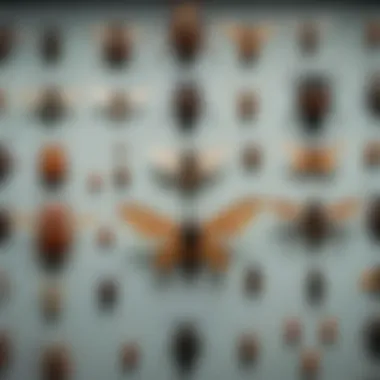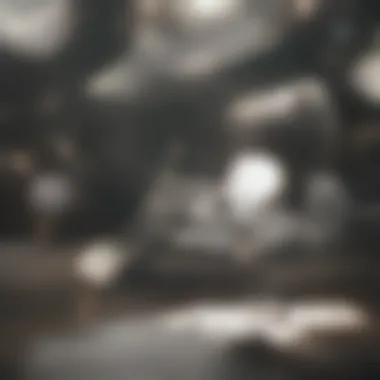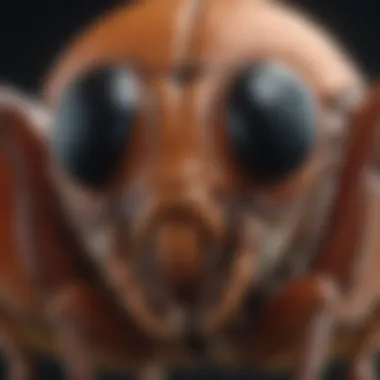Understanding Entomological Supply: A Comprehensive Overview


Intro
Entomology, the study of insects, is a fundamental field in natural sciences. This discipline not only provides insight into biodiversity but also serves practical applications across agriculture, medicine, and environmental management. An essential component of entomology is the concept of entomological supply, which encompasses the materials and specimens necessary for research and education.
Understanding the intricacies of entomological supply aids students, educators, and professionals to better engage with the subject. With it, one can effectively address inquiries related to insect behavior, ecology, and taxonomy. The objective of this article is to provide a comprehensive exploration of the various facets of entomological supply.
Notably, recent advances in the field have reshaped how researchers operate, bringing with them new discoveries and technological innovations. Simultaneously, a well-defined methodology remains crucial for robust research outcomes. By unraveling these layers, the reader will gain a holistic view of the significance of entomological supply in contemporary research.
Defining Entomological Supply
The term entomological supply encompasses a range of materials, tools, and specimens essential for the study of insects and related fields. Understanding this topic is crucial, as it directly influences the quality and depth of research within entomology. Professionals and students alike must grasp the significance of this supply chain — from procurement to application — in order to maximize their studies and findings.
What is Entomological Supply?
Entomological supply refers to the products and resources utilized in the scientific examination of insects. This can include preserved specimens, field collection tools, and laboratory equipment. Each component plays a vital role in the processes of collection, study, and analysis. For instance, preserved insect specimens serve as valuable references for classification and taxonomic studies, while equipment like microscopes and dissection tools facilitate detailed examinations.
Furthermore, the evolving nature of entomological research demands constant updates and innovations in supplies. Emerging techniques and technologies redefine what constitutes entomological supply, making it essential for professionals to stay informed about new developments.
Importance in Scientific Research
Understanding entomological supply is key to ensuring successful research outcomes. High-quality specimens and equipment can significantly impact the validity of research findings. For example, accurate identification of insect species is only possible when researchers have access to well-preserved specimens and reliable identification tools.
Moreover, various fields benefit from the expertise in entomological supply:
- Biodiversity studies rely on accurate collections of insect species to assess environmental conditions.
- Agricultural research utilizes entomological materials for pest control studies, informing sustainable practices to preserve ecosystems.
- Medical entomology uses insect specimens to explore vectors of diseases, contributing to public health.
The implications extend beyond the laboratory. A solid understanding of entomological supplies fosters collaboration, sharing of resources, and collective advancements in research. In summary, the nuances of entomological supply reinforce its role as an integral element in the broader field of entomology, bridging the gap between theory and practical application.
"Awareness of how entomological supplies are defined and utilized ultimately enhances the quality and scope of research in entomology."
By diving deep into what entomological supply truly means and understanding its significance, scholars, educators, and professionals can better navigate and contribute to the intricate world of entomological research.
Types of Entomological Supplies
Understanding the various types of entomological supplies is crucial for both educational and research purposes. Each type of supply serves a specific role, aiding in the accurate study and collection of entomological data. As the field of entomology evolves, the demand for precise and diverse supplies continues to rise. Using the appropriate types of supplies not only enhances the quality of research but also ensures ethical and effective practices in collections and studies.
Preserved Specimens
Preserved specimens are essential in entomological studies as they provide a reference point for researchers and educators.
Methods of Preservation
Preservation methods directly influence the longevity and quality of specimens. Techniques such as drying, freezing, or using chemicals like formaldehyde are common. Each method has its own merits. For instance, freezing prevents decomposition and maintains physical characteristics essential for identification. This method is favored for delicate specimens that may be damaged by harsher processes. However, it does require proper storage facilities and can be limited by power sources.
The selection of a preservation method may depend on the goals of the study and the resources available. For instance, the use of chemicals can ensure color retention but involves handling materials that may be hazardous.
Commonly Used Preservatives
Preservatives such as ethanol and isopropanol are widely used among researchers. Ethanol is particularly valuable due to its availability and effectiveness at preventing microbial growth. This characteristic makes it a popular choice for many in the field. On the downside, prolonged exposure to ethanol can affect the integrity of certain insect features, potentially complicating later analysis.
The choice of preservatives also depends on the intended examination of the specimen. Some preservatives might be excellent for long-term storage but less effective for visual studies due to color changes or tissue alterations over time.
Field Collection Equipment
Field collection equipment is crucial for gathering data in natural habitats. The right tools aid in capturing a variety of insect species efficiently.


Collecting Nets
Collecting nets serve a fundamental role in fieldwork. They come in various shapes and sizes, allowing for targeted insect capture. The lightweight design facilitates ease of use and mobility for researchers. This aspect makes collecting nets a favorable option for those engaging in long hours of fieldwork.
While collecting nets are efficient, their effectiveness is often influenced by technique and experience of the collector. Insects that are fast or highly mobile may require specific strategies to capture correctly.
Traps and Bait Systems
Traps and bait systems are designed for specific insect behavior. These tools can be strategically placed to capture targeted species over time. One advantage of these traps is that they reduce the need for constant monitoring, allowing researchers to collect data more efficiently. For instance, light traps lure insects using artificial light, making them invaluable for studying nocturnal species.
However, traps can sometimes catch non-target species, leading to bycatch. This aspect should be considered when planning a field study, as it can affect data accuracy and the understanding of local biodiversity.
Laboratory Supplies
In the laboratory, various supplies facilitate detailed observations and dissections, contributing to a deeper understanding of entomology.
Microscopes
Microscopes are fundamental for examining the minute details of insect anatomy. The ability to magnify small structures enables researchers to identify species and understand their biology more clearly. Digital microscopes enhance this by allowing for easy documentation and sharing of findings.
However, the need for trained personnel to operate advanced models can be a constraint, requiring investment in training alongside equipment.
Dissection Tools
Dissection tools are vital for detailed anatomical studies. Precision tools help in analyzing structures without damage. High-quality dissection kits that include scalpels, forceps, and scissors are essential for these tasks. The ease of use these tools provide can greatly enhance the learning experience for students and researchers alike.
Nevertheless, proper maintenance of dissection tools is crucial. Dull tools may lead to inaccuracies in dissections and can be a source of frustration for users.
Sources of Entomological Supply
The sources of entomological supply are essential to understanding how specimens and equipment are acquired for both education and research purposes. These sources provide various materials that facilitate the study of insects and their roles in ecosystems. Knowing where to obtain high-quality specimens and tools can significantly impact the research outcomes and educational effectiveness. This section outlines three primary sources: commercial suppliers, academic institutions, and field collectors and researchers.
Commercial Suppliers
Commercial suppliers play a vital role in the entomological supply chain. They provide a wide range of insect specimens, equipment, and educational resources. Companies like BioQuip and Carolina Biological Supply cater to students and researchers by offering preserved specimens and tools for field collection. Their online catalogs offer a convenient way for educators and researchers to access materials without geographical limitations.
The advantages of using commercial suppliers include:
- Wide selection: They stock numerous species and types of supplies.
- Quality assurance: Most reputable suppliers ensure that their products meet specific standards.
- Convenience: Easy online ordering and delivery enhance accessibility for customers.
Despite these benefits, it's important to consider the ethical implications of sourcing specimens. Ensuring that suppliers follow sustainable practices is essential for the health of insect populations.
Academic Institutions
Academic institutions contribute significantly to the entomological supply landscape. They often house extensive collections of preserved specimens, created over many years of research. Universities and museums may offer access to these collections for study and educational purposes. Institutions like the Smithsonian National Museum of Natural History have vast entomological collections, providing invaluable resources for researchers and students.
These institutions often engage in:
- Research collaborations: Offering access to specimens for broader academic projects.
- Workshops and training: Educating students and professionals on specimen collection and identification.
Partnerships between universities and commercial suppliers also emerge. This synergy helps to enhance the quality and quantity of available resources, bridging the gap between theoretical study and practical application.
Field Collectors and Researchers
Field collectors and researchers represent another crucial source of entomological supply. They regularly gather specimens in natural environments, often contributing to databases and collections. This group includes not only professional entomologists but also hobbyists who understand the importance of biodiversity.


Among the benefits of obtaining specimens directly from field collectors are:
- Fresh specimens: These are often more suitable for specific studies, reflecting current biodiversity.
- Local knowledge: Collectors can provide insights into regional ecosystems that enhance research accuracy.
However, challenges exist in this area. The legality and ethical considerations of collecting specimens must be respected to ensure the sustainability of insect populations. Permits and local regulations often guide the collection process.
In summary, sourcing entomological materials from commercial suppliers, academic institutions, and field collectors forms a fundamental backbone for research and educational practices in entomology.
Understanding these sources helps in recognizing the broader implications for research quality and ecological sustainability.
Applications of Entomological Supply
Understanding the applications of entomological supply is essential for comprehensing its role in education and research. This underscores the significance of various materials and tools in advancing entomological studies. Both students and professionals benefit from knowing how these supplies are utilized effectively.
Educational Purposes
Teaching Tools in Entomology
Teaching tools in entomology play a vital role in education. They provide interactive methods for students to engage with the subject matter. This enhances understanding of intricate concepts like insect anatomy and behavior. Field kits, preserved specimens, and presentation aids can make learning more effective.
A key characteristic of teaching tools is their hands-on nature. Students can study real specimens, which brings theoretical knowledge to life. This method is often seen as a beneficial choice in classrooms due to its direct application to real-world scenarios. However, practical limitations exist, such as availability and cost of specimens. A unique feature is the integration of technology, like interactive software, that facilitates exploration of entomological data.
Laboratory Exercises
Laboratory exercises are another cornerstone of the educational landscape in entomology. These exercises allow students to apply theoretical knowledge in a controlled environment. They often include activities like dissection and morphological analysis. A strong point of laboratory exercises is their ability to develop critical thinking skills.
These exercises are popular because they cultivate hands-on experiences that reinforce classroom learning. However, laboratory work requires strict adherence to safety protocols, which can sometimes limit student engagement. A unique characteristic of laboratory exercises is their potential for collaborative projects, promoting teamwork among students.
Research and Development
Taxonomic Studies
Taxonomic studies hold great importance in entomological research and aim to classify and name insect species. They provide a framework for understanding biodiversity. A key characteristic of taxonomic studies is their reliance on precise identification, which is crucial for ecological assessments.
Taxonomic classification is a beneficial undertaking, as it serves as the foundation for various other scientific inquiries. However, challenges like discrepancies in classification systems exist. A unique advantage of taxonomic studies is their potential to discover unknown species, adding to the global understanding of biodiversity.
Ecological Research
Ecological research in entomology is critical for understanding ecosystems. It examines how insects interact with their environment and other organisms. The key characteristic of ecological research is its focus on relationships within ecosystems. This gives insights into species roles and environmental impacts.
Ecological studies are vital as they help in assessing ecosystem health and the effects of environmental changes. One unique advantage is the potential for applying research outcomes to conservation efforts. However, challenges may arise from the complexity of ecological interactions, making it difficult to draw straightforward conclusions.
"Entomological supply is essential in educational settings and research environments, allowing for enriched learning and precise investigation."
Overall, the applications of entomological supply are multifaceted, supporting both educational and research needs. Understanding these applications enhances the appreciation of entomology's contributions to science and education.
Challenges in Entomological Supply
The challenges faced in entomological supply are significant and multifaceted. Understanding these challenges is essential for ensuring the sustainability and ethical procurement of entomological materials. These challenges range from concerns about sustainability to legal and ethical considerations that govern the collection and usage of specimens.
Sustainability Concerns
Over-Collection Risks
Over-collection poses a serious threat to insect populations. When too many specimens are gathered from a habitat, it can lead to a decline in local species. This not only impacts ecological balance but also compromises future research opportunities. The key aspect of over-collection risks lies in understanding the delicate equilibrium within ecosystems. Therefore, this article emphasizes the need for assessing collection strategies carefully, ensuring that they do not deplete populations. A beneficial choice in this context is implementing regulated collection techniques that consider population health. The unique feature of managing over-collection is that it allows researchers to obtain necessary samples while maintaining biodiversity. However, if unchecked, it can lead to substantial disadvantages, such as loss of critical species needed for research and education.


Impact on Biodiversity
The impact on biodiversity is a crucial concern linked directly with sustainability. Biodiversity contributes to the resilience of ecosystems, allowing them to recover from disturbances. A key characteristic of biodiversity's impact is how insect diversity affects ecosystem functions like pollination and decomposition. This article points out that a reduction in insect populations can lead to cascading effects throughout the food web. The unique aspect of this situation is that it creates a feedback loop; as certain species diminish, ecosystems may fail to function optimally. The advantages of maintaining high biodiversity include enhanced ecosystem services, while the significant disadvantage of loss can be irreversible and detrimental to both natural habitats and research potential.
Legal and Ethical Considerations
Effective legal frameworks and ethical practices are vital in guiding entomological supply. Understanding the regulations that govern the collection and distribution of insect specimens plays a key role in responsible research and education.
Permits and Regulations
Permits and regulations are necessary to enforce sustainable entomological practices. These regulations typically require researchers to obtain permission before collecting specimens, which helps to monitor population status and ensure that collection does not threaten species. A critical feature of this approach is regulation adherence across different jurisdictions. The benefits of having stringent regulations are multifaceted; they promote ecological responsibility and foster an environment where research can continue without compromising species. However, such regulations may also introduce complexities that some researchers find restrictive. Navigating through legal frameworks can sometimes become a barrier, creating uncertainties in the research process.
Ethical Collection Practices
Ethical collection practices are crucial for minimizing the negative impact of entomological supply on ecosystems. These practices often emphasize transparency and respect for nature, focusing on how specimens are gathered. A key characteristic of ethical practices is the emphasis on minimizing harm during collection. This article highlights the importance of training researchers on best practices, ensuring they make informed decisions. The advantage of such standards is that they promote a balance between scientific inquiry and environmental stewardship. Nonetheless, the challenge remains in consistently enforcing these practices across various researchers and institutions, potentially leading to discrepancies in how ethical standards are applied.
Understanding the challenges in entomological supply is necessary for sustaining research and protecting biodiversity.
Overall, the challenges in entomological supply illustrate the need for a conscious effort towards sustainable practices, adherence to legal frameworks, and commitment to ethical standards within the research community. Addressing these issues not only supports ecological integrity but also enhances the validity and effectiveness of entomological research.
Future Directions in Entomological Supply
The landscape of entomological supply is evolving as new technologies and methodologies emerge. Understanding these future directions is essential for researchers, educators, and students alike. It can improve research efficiency, enhance educational experiences, and promote community engagement through new initiatives. The focus in this section will be on emerging technologies and the integration of citizen science.
Emerging Technologies
Digital Identification Tools
Digital identification tools are gaining traction in the field of entomology. These software and applications aid in the identification of insect species through user-friendly interfaces. A key characteristic of digital identification tools is their ability to use machine learning algorithms. These algorithms analyze images and compare them against vast databases, making identification faster and more accurate.
The significant benefit of utilizing digital identification tools is their accessibility. Many tools are available for free or at a low cost, allowing for wider use among both professionals and amateurs. However, a unique feature, such as real-time feedback during the identification process, can be an advantage. Yet, limitations exist, as some tools may not have comprehensive databases for all regions, presenting a challenge for users in less-researched areas.
Virtual Laboratories
Virtual laboratories represent another vital advancement in entomological supply. They create a simulated environment where researchers and students can study insect behavior, conduct experiments, and analyze findings without the constraints of physical laboratories. One key characteristic of virtual laboratories is their flexibility. They allow users to conduct experiments at their convenience and repeat them easily.
The major advantage of virtual laboratories is the reduction of costs associated with physical equipment and space. Students can learn through simulations that may be too expensive or impractical in real life. However, limitations include the lack of real-life interaction with specimens, which can be crucial for skills development in entomology.
Integrating Citizen Science
Integrating citizen science into entomological research is a promising future direction. This approach invites non-professionals to aid in data collection and observation, providing critical data on insect populations and biodiversity. Citizen science can enhance public awareness and appreciation for entomological studies. By engaging with their local ecosystems, individuals contribute valuable insights that professional researchers might overlook.
Moreover, creating platforms for citizen participation broadens the scope of data collection, especially in remote locations or specific ecosystems. Additionally, this can lead to more community-driven conservation efforts. Thus, integrating citizen science not only expands research capabilities but also fosters a deeper connection between communities and their environments.
Ending
The conclusion serves to encapsulate the essential aspects of entomological supply discussed throughout the article. It acts not only as a summary but also as a reflection of the significance of these supplies in various fields. By understanding the diversity of entomological supplies, from preserved specimens to field equipment, readers gain insight into their pivotal role in research and education.
Recap of Key Points
In this article, we have touched upon several crucial topics regarding entomological supply:
- Definition: We explored what entomological supply encompasses, highlighting its significance in both academic and practical contexts.
- Types of Supplies: The article detailed different types of entomological supplies, including preserved specimens, field collection equipment, and laboratory supplies.
- Sources: We identified where these supplies can be obtained, such as commercial suppliers, academic institutions, and field collectors.
- Applications: Different applications of entomological supplies in education and research were discussed, showcasing their relevance in taxonomic studies and ecological research.
- Challenges: Sustainability and ethical considerations were outlined, emphasizing the need for responsible practices in supplying and using these materials.
- Future Directions: Emerging technologies and the growing integration of citizen science were highlighted as key areas for future development in the field.
This structured overview aids in understanding the complexities and the broader implications of entomological supply.
The Importance of Continued Exploration
Continued exploration of entomological supply is essential for several reasons. As new technologies and methodologies emerge, the standards and practices regarding the collection and use of these supplies can evolve significantly. The integration of digital identification tools and virtual laboratories illustrates how technology can enhance understanding and accessibility in entomology.
Furthermore, engaging the public and fostering interest through citizen science initiatives can contribute significantly to data collection and environmental monitoring. Encouraging enthusiasts to participate can lead to greater biodiversity knowledge and conservation efforts.
Maintaining an informed approach towards entomological supply ensures that future research is not only fruitful but also ethical and sustainable. As researchers, educators, and students consume this knowledge, they help cultivate a more informed community that values ecological balance and biodiversity.















